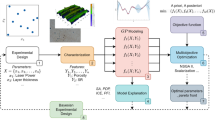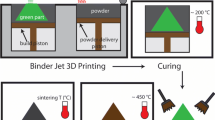Abstract
In recent years, finite element simulation has been increasingly combined with optimization techniques and applied to optimization of various metal-forming processes. The robustness and efficiency of process optimization are critical factors to obtain ideal results, especially for those complicated metal-forming processes. Gradient-based optimization algorithms are subject to mathematical restrictions of discontinuous searching space, while nongradient optimization algorithms often lead to excessive computation time. This paper presents a novel intelligent optimization approach that integrates machine learning and optimization techniques. An intelligent gradient-based optimization scheme and an intelligent response surface methodology are proposed, respectively. By machine learning based on the rough set algorithm, initial total design space can be reduced to self-continuous hypercubes as effective searching spaces. Then optimization algorithms can be implemented more effectively to find optimal design results. An extrusion forging process and a U channel roll forming process are studied as application samples and the effectiveness of the proposed approach is verified.
Similar content being viewed by others
References
Box GEP, Draper NR (1987) Empirical model-building and response surfaces. Applied probability and statistics. Wiley, New York
Cheng JG, Yao YL (2004) Process synthesis of laser forming by genetic algorithm. Int J Mach Tools Manuf 44:1619–1628
Choi KK, Kim NH (2002) Design optimization of springback in a deepdrawing process. AIAA J 40:147–153
Chung JS, Hwang SM (1997) Application of a genetic algorithm to the optimal design of the die shape in extrusion. J Mater Process Technol 72:69–77
Fourment L, Chenot JL (1996) Optimal design for non-steady-state metal forming processes-1 shape optimization method. Int J Numer Methods Eng 39:33–50
Han CS, Grandhi RV, Srinivasan R (1993) Optimum design of forging die shapes using nonlinear finite element analysis. AIAA J 31:774–784
Heislitz F, Livatyali H, Ahmetoglu MA, Kinzel GL, Altan T (1996) Simulation of roll forming process with the 3-D FEM code PAM-STAMP. J Mater Process Technol 59:59–67
Hilding D (2000) Heuristic smoothing procedure for avoiding local optima in optimization of structures subject to unilateral constraints. Struct Multidiscipl Optim 20:29–36
Huh H, Kim SH (2001) Optimum process design in sheet metal forming with finite element analysis. J Eng Mater Technol 123:476–481
Kleiber M, Knabel J, Rojek J (2004) Response surface method for probabilistic assessment of metal forming failures. Int J Numer Methods Eng 60:51–67
Lawrence CT, Tits AL (1996) Nonlinear equality constraints in feasible sequential quadratic programming. Optim Methods Softw 6:265–282
Liew KM, Tan H, Ray T, Tan MJ (2004) Optimal process design of sheet metal forming for minimum springback via an integrated neural network evolutionary algorithm. Struct Multidiscipl Optim 26:284–294
Luet D (1998) Quality function approach to design and optimization of stamping process: application to an industrial case. SAE Paper 980442, pp 99–105
Maker BN (2000) On drawbeads in sheet metal forming. SAE Paper 01-1107, pp 121–125
Myers RH (1971) Response surface methodology. Allyn and Bacon, Boston
Nakamura Y, Ohata T, Katayama T (1998) Optimum die design for sheet metal forming process by using finite element and discretized optimization methods, simulation of materials processing: theory, methods and application, Rotterdam, The Netherlands, pp 787–792
Park SH (1978) Experimental design for fitting segmented polynomial regression models. Technometrics 20:151–154
Pawlak Z (1982) Rough sets. Int J Comput Inf Sci 20:341–356
Roy S, Ghosh S, Shivpuri R (2000) A new approach to optimal design of multi-stage metal forming processes with micro genetic algorithms. Int J Mach Tools Manuf 37:29–44
Sugeno M, Yasukawa T (1993) A fuzzy logic based approach to qualitative modeling. IEEE Trans Fuzzy Syst 1:7–31
Thiyagarajan N, Grandhi RV (2005) Multi-level design process for 3-D preform shape optimization in metal forming. J Mater Process Technol 170:421–429
Wang GG (2003) Adaptive response surface method using inherited Latin hypercube design points. J Mech Des 125:210–220
Winer BJ (1971) Statistical principles in experimental design, 2nd edn. McGraw-Hill, New York
Wu CY, Hsu YC (2002) Optimal shape design of an extrusion-forging die using a polynomial network and a genetic algorithm. Int J Adv Manuf Technol 20:128–137
Wu CD, Yue Y, Li MX, Adjei O (2004) The rough set theory applications. Eng Comput 21:488–511
Xuan GN, Cheng RW (2000) Genetic algorithm and engineering design. Science Press, Beijing
Yang JB, Jecon BH, Oh SI (2001) Design sensitivity analysis and optimization of hydroforming process. J Mater Process Technol 113:666–672
Yin JL, Li DY, Wang YC (2004) Knowledge discovery from finite element simulation data. In: Third international conference on machine learning cybernetics, pp 1335–1340
Zhao GQ, Wright E, Grandhi RV (1997) Sensitivity analysis based preform die shape design using the finite element method. J Mater Eng Perform 6:303–310
Author information
Authors and Affiliations
Corresponding author
Rights and permissions
About this article
Cite this article
Li, D.Y., Peng, Y.H. & Yin, J.L. Optimization of metal-forming process via a hybrid intelligent optimization technique. Struct Multidisc Optim 34, 229–241 (2007). https://doi.org/10.1007/s00158-006-0075-1
Received:
Revised:
Published:
Issue Date:
DOI: https://doi.org/10.1007/s00158-006-0075-1




